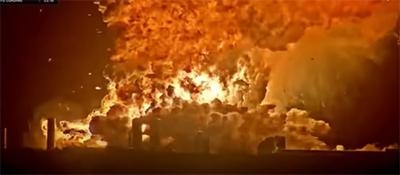Fri, Jun 20, 2025
Vehicle Experienced “Anomaly” During Fuel Loading For Static Fire Test
A SpaceX Starship second stage, Ship 36, mounted on a test stand loading fuel for a static fire test was destroyed in a huge explosion that was seen and heard for miles around Starbase in South Texas, startling residents in Cameron County where Starbase is located.

The Cameron County Sheriff’s Office confirmed a loud rumble was heard and that it was an explosion from one of SpaceX’s static tests. No injuries were reported.
SpaceX posted an update on X regarding the explosion experienced by Starship: “On Wednesday, June 18 at approximately 11 p.m. CT, the Starship preparing for the tenth flight test experienced an anomaly while on a test stand at Starbase.
After completing a single-engine static fire earlier this week, the vehicle was in the process of loading cryogenic propellant for a six-engine static fire when a sudden energetic event resulted in the complete loss of Starship and damage to the immediate area surrounding the stand. The explosion ignited several fires at the test site which remains clear of personnel and will be assessed once it has been determined to be safe to approach. Individuals should not attempt to approach the area while safing operations continue.”
No injuries were reported, and SpaceX said all personnel were safe and accounted for since a safety zone was established around the test site and maintained throughout the operation.

In addition, SpaceX emphasized that there are no hazards to surrounding communities in the Rio Grande Valley. Independent testing previously showed that Starship materials pose no chemical, biological, or toxicological risks. SpaceX is coordinating with local, state and federal agencies on safety and environmental matters.
The update continued, “Engineering teams are actively investigating the incident and will follow established procedures to determine root cause. Initial analysis indicates the potential failure of a pressurized tank known as a COPV, or composite overwrapped pressure vessel, containing gaseous nitrogen in Starship’s nosecone area, but the full data review is ongoing. There is no commonality between the COPVs used on Starship and SpaceX’s Falcon rockets.
More News
He Attempted To Restart The Engine Three Times. On The Third Restart Attempt, He Noticed That Flames Were Coming Out From The Right Wing Near The Fuel Cap Analysis: The pilot repor>[...]
Make Sure You NEVER Miss A New Story From Aero-News Network Do you ever feel like you never see posts from a certain person or page on Facebook or Instagram? Here’s how you c>[...]
From 2009 (YouTube Edition): Leading Air Show Performers Give Their Best Advice for Newcomers On December 6th through December 9th, the Paris Las Vegas Hotel hosted over 1,500 air >[...]
Aero Linx: NASA ASRS ASRS captures confidential reports, analyzes the resulting aviation safety data, and disseminates vital information to the aviation community. The ASRS is an i>[...]
“For our inaugural Pylon Racing Seminar in Roswell, we were thrilled to certify 60 pilots across our six closed-course pylon race classes. Not only did this year’s PRS >[...]
 NTSB Final Report: Rutan Long-EZ
NTSB Final Report: Rutan Long-EZ ANN FAQ: Turn On Post Notifications
ANN FAQ: Turn On Post Notifications Classic Aero-TV: ICAS Perspectives - Advice for New Air Show Performers
Classic Aero-TV: ICAS Perspectives - Advice for New Air Show Performers ANN's Daily Aero-Linx (06.28.25)
ANN's Daily Aero-Linx (06.28.25) Aero-News: Quote of the Day (06.28.25)
Aero-News: Quote of the Day (06.28.25)




